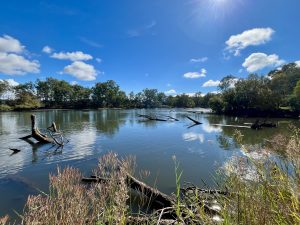Our final Night Walk for the holidays explored the very special ‘Drapers block’, part of Castle Creek Conservation Reserve. Karen Retra and Danny Jones led ten excited people on an adventure along the bush trails, focusing skyward on the nightlife in the trees.
The group were fortunate to have Ranger Dan as chief spotter – he has a keen eye for night time wildlife. Ringtail and brushtail possums were our most common finds. One of the group spotted a possum drey right next to a possum, who cautiously peered down at us.
We discussed FrogID and frogs at a dam and Karen made some recordings. The Eastern Dwarf Tree Frog, Litoria fallax, was calling, along with at least three other species. As this frog is a relatively recent arrival in our area, we’re encouraging anyone who hears it to submit records via the FrogID app to get a better idea of how far these small, bright green tree frogs have spread. They have an unusual call and didn’t call during the colder months but are back on the job now. You can check out their profile – and hear their call – on FrogID frogid.net.au/frogs/litoria-fallax.
There was a bit of rain as we passed through the most forested part of our walk. Even that didn’t deter the keen night walkers, who thought it added to the atmosphere! We spied some small shiny eyes that we thought might belong to gliders, but they were too well hidden behind the leaves for us to be completely sure. Parklands Rangers have certainly found gliders previously in nestboxes close by.
After the little rain shower, and having said we weren’t looking for frogs, only listening for them, we saw not one but two small frogs along our path. We stopped to check them out. They were just a few centimetres long and well camouflaged against the now moist soil.
And just as we were all getting ready to head home, one of the kids spotted this brightly coloured moth on the road. It’s a Crimson Tiger Moth, Ardices (also known as Spilosoma) curvata. Danny reports that it landed on his face first! We all admired its colours and the detail of the feathery (bipectinate) antennae. This special find was one of four records we added to iNaturalist as a result of our walk.
Thanks to Karen Retra and Wodonga Urban Landcare Network for the great walk report. This community event was supported by the Victorian Government.




Crimson Tiger Moth (formerly known as Spilosoma curvata)






